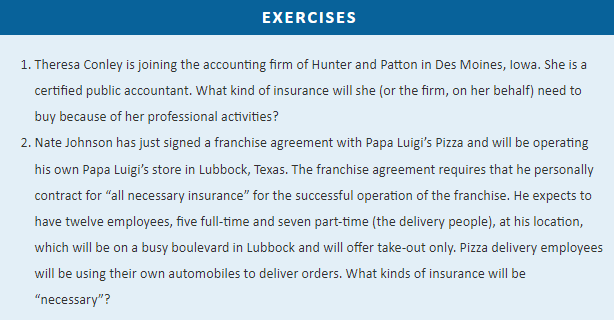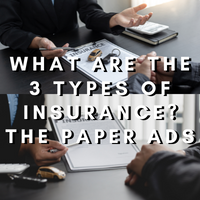The Paper Ads Present’s:
Definitions and Types of Insurance
Certain terms are usefully detailed at the outset. Insurance is a contract of repayment. For example, it refund for losses from stated insecurity, such as fire, hurricane, and earthquake. An insurer is the company or person who promises to refund. The insured (sometimes called the assured) is the one who receives the payment, except in the case of life insurance, where payment goes to the beneficiary named in the life insurance contract. The premium is the consideration paid by the insured—usually annually or semiannually—for the insurer’s promise to refund. The contract itself is called the policy. The events insured against are known as risks or insecurity.
Types of Insurance for the Individual
Life Insurance
Life insurance provides for your family or some other named recipient on your death. Two general types are available: term insurance provides insurance only during the term of the policy and pays off only on the insured’s death; whole-life insurance provides savings as well as insurance and can let the insured collect before death.
Health Insurance
Health insurance covers the expenditure of hospitalization, visits to the doctor’s office, and prescription medicines. The most useful policies, provided by many employers, are those that cover 100 percent of the expenditures of being hospitalized and 80 percent of the charges for medicine included doctor’s fee. Usually, the policy will contain a deductible amount; the insurer will not make payments until after the deductible amount has been reached. Twenty years ago, the deductible might have been the first $100 or $250 of charges; today, it is often much wider.
Disability Insurance
A disability policy pays a certain % of an employee’s wages (or a fixed sum) weekly or monthly if the employee becomes unfit to work due to illness or an accident. Premiums are lower for policies with longer waiting cycle’s before payments must be made: a policy that begins to pay a disabled worker within thirty days might cost twice as much as one that defers payment for 6 months.
Homeowner’s Insurance
A homeowner’s policy provides insurance for damages or losses due to fire, theft, and other named insecurity. No policy often covers all insecurity. The homeowner must estimate his needs by looking to the likely risks in his area—earthquake, hailstorm, flooding, and so on. Homeowner’s policies provide for shortened coverage if the property is not insured for at least 80 % of its replacement costs. In inflationary times, this need means that the owner must adjust the policy limits upward each year or purchase a rider that automatically fixes for inflation. Where property values ‘ve dropped substantially, the owner of a home (or a commercial building) might find savings in lowering the policy’s insured amount.
Automobile Insurance
Automobile insurance is perhaps the most commonly held type of insurance. Automobile policies are obligatory in at least minimum amounts in all states. The typical automobile policy covers costs for human injury and property damage, medical payments, damage to or loss of the car itself, and attorneys’ fees in case of a lawsuit.
Other Liability Insurance
In this litigious society, a person can be indict for just about anything: a slip on the walk, a harsh and misleading word spoken in anger, an accident on the ball field. A personal liability policy covers many sorts of these risks and can give coverage in excess of that provided by homeowner’s and automobile insurance. Such umbrella coverage is usually fairly inexpensive, perhaps $250 a year for $1 million in liability.
Types of Business Insurance
Workers’ Compensation
Almost every business in every state must insure against injury to workers on the job. Some may do this through self-insurance—that is, by setting aside certain reserves for this emergency. Most smaller businesses purchase workers’ compensation policies, available through commercial insurers, trade associations, or state funds.
Automobile Insurance
Any business that uses motor vehicles should maintain at least a leas-possible automobile insurance policy on the vehicles, covering personal injury, property damage, and general liability.
Property Insurance
No business should take a chance of leaving unprotected its buildings, permanent fixtures, machinery, inventory, and the like. Many property policies cover damage or loss to a company’s own property or to property of others stored on the premises.
Malpractice Insurance
Professionals such as doctors, lawyers, and accountants will often purchase malpractice insurance to protect against claims made by disgruntled patients or clients. For doctors, the cost of such insurance has been increasing over the past thirty years, widely because of wide jury awards against physicians who are negligent in the practice of their profession.
Business Interruption Insurance
Depending on the volume of the business and its susceptibility to losses resulting from damage to essential operating material or other property, a company may wish to purchase insurance that will pay loss of earnings if the business operations are disrupted in some way—by a strike, loss of power, loss of raw material supply, and so on.
Liability Insurance
Businesses face a host of risks that could be result in significant liabilities. Many sorts of policies are available, including policies for owners, land owners, and tenants (covering liability incurred on the premises); for manufacturers and contractors (for liability incurred on all premises); for a company’s products and completed operations (for liability that results from warranties on products or injuries caused by products); for owners and contractors (protective liability for damages caused by individual contractors engaged by the insured); and for contractual liability (for failure to abide by performances required by specific contracts).
Some years ago, different sorts of independent and business coverage had to be purchased separately and often from different companies. Today, most insurance is available on a volume basis, through single policies that cover the most important risks. These are often called multiperil policies.


